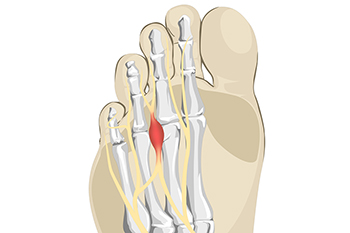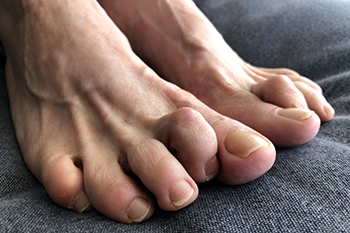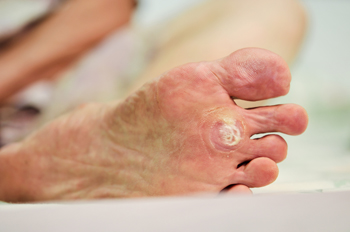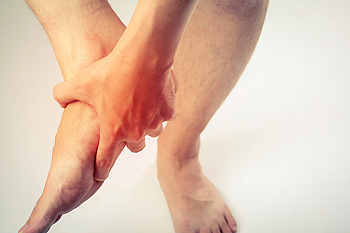Items filtered by date: June 2022
Gout Pain Can Be Managed
Common Symptoms of Morton’s Neuroma

Research has indicated that the foot condition known as Morton’s neuroma is generally simple to diagnose. The common symptoms that many people experience with this ailment can include a tingling sensation between the second and third toes, or the fourth and fifth toes. It may begin after wearing specific types of shoes, or from walking or standing for an extended period of time. Many people can develop this condition from wearing high heels. This can be a result of a lack of adequate space for the toes to move freely in. A clicking feeling and sound may be felt in the ball of the foot, and it can feel uncomfortable. Many people often equate this feeling with the sensation of stepping on a marble, or having an out of place seam from a sock. Additionally, the toes can separate with a large Morton’s neuroma, and medical attention is needed. The toes may become numb, and it can be quite painful to walk. If you have any of these symptoms, it is advised that you place yourself under the care of a podiatrist who can use various conservative methods, or possibly even perform surgery, to treat Morton’s neuroma.
Morton’s neuroma is a very uncomfortable condition to live with. If you think you have Morton’s neuroma, contact the foot specialists of Spartan Podiatry. Our doctors will attend to all of your foot care needs and answer any of your related questions.
Morton’s Neuroma
Morton's neuroma is a painful foot condition that commonly affects the areas between the second and third or third and fourth toe, although other areas of the foot are also susceptible. Morton’s neuroma is caused by an inflamed nerve in the foot that is being squeezed and aggravated by surrounding bones.
What Increases the Chances of Having Morton’s Neuroma?
- Ill-fitting high heels or shoes that add pressure to the toe or foot
- Jogging, running or any sport that involves constant impact to the foot
- Flat feet, bunions, and any other foot deformities
Morton’s neuroma is a very treatable condition. Orthotics and shoe inserts can often be used to alleviate the pain on the forefront of the feet. In more severe cases, corticosteroids can also be prescribed. In order to figure out the best treatment for your neuroma, it’s recommended to seek the care of a podiatrist who can diagnose your condition and provide different treatment options.
If you have any questions, please feel free to contact our offices located in Battle Creek, and Marshall, MI . We offer the newest diagnostic and treatment technologies for all your foot care needs.
Certain Medical Conditions May Lead To Hammertoe

Healthy toes play a significant role in standing and walking. The foot condition that is known as hammertoe is considered to be a deformity and can cause difficulty in walking. It is a noticeable condition that causes the second toe to bend downwards. This can overlap other toes, and corns may develop on top of the affected toes as they rub against the shoe. It may become difficult to straighten the toe, and surgery could become necessary. Hammertoe can occur from genetic reasons and from wearing shoes that do not have adequate room for the toes to move freely. There may also be existing medical conditions that may lead some patients to develop hammertoe. These include having a high or low arch, arthritis, or bunions. People who are diabetic may also be susceptible and may not feel blisters or calluses that can form. Relief may be found when wearing shoes that fit correctly as well as using protective pads on top of the toes. Hammertoe is a condition that is treated by a podiatrist, and it is suggested that you schedule a consultation so the correct treatment can begin.
Hammertoe
Hammertoes can be a painful condition to live with. For more information, contact the foot specialists from Spartan Podiatry. Our doctors will answer any of your foot- and ankle-related questions.
Hammertoe is a foot deformity that affects the joints of the second, third, fourth, or fifth toes of your feet. It is a painful foot condition in which these toes curl and arch up, which can often lead to pain when wearing footwear.
Symptoms
- Pain in the affected toes
- Development of corns or calluses due to friction
- Inflammation
- Redness
- Contracture of the toes
Causes
Genetics – People who are genetically predisposed to hammertoe are often more susceptible
Arthritis – Because arthritis affects the joints in your toes, further deformities stemming from arthritis can occur
Trauma – Direct trauma to the toes could potentially lead to hammertoe
Ill-fitting shoes – Undue pressure on the front of the toes from ill-fitting shoes can potentially lead to the development of hammertoe
Treatment
Orthotics – Custom made inserts can be used to help relieve pressure placed on the toes and therefore relieve some of the pain associated with it
Medications – Oral medications such as anti-inflammatories or NSAIDs could be used to treat the pain and inflammation hammertoes causes. Injections of corticosteroids are also sometimes used
Surgery – In more severe cases where the hammertoes have become more rigid, foot surgery is a potential option
If you have any questions please contact our offices located in Battle Creek, and Marshall, MI . We offer the newest diagnostic and treatment technologies for all your foot and ankle needs.
Walking May Be Affected by a Plantar Wart

Research has shown that plantar warts affect approximately ten percent of the population. They are warts that develop on the sole of the foot, and grow inward as a result of the weight the feet endure on a daily basis. They are generally caused by the human papilloma virus (HPV), and can enter the body through small cuts in the skin on the feet. They are prone to developing on the ball and heel of the foot, and are considered to be hyperkeratotic eruptions. Plantar warts can cause severe pain and discomfort, and aggressive treatment may be necessary to relieve the pain while walking. Some patients have to alter their style of walking if they have a plantar wart, and their posture may be affected. If you have a wart on the bottom of your foot, please seek the counsel of a podiatrist who can effectively treat this condition.
Plantar warts can be very uncomfortable. If you need your feet checked, contact the foot specialists from Spartan Podiatry. Our doctors will assist you with all of your foot and ankle needs.
About Plantar Warts
Plantar warts are the result of HPV, or human papillomavirus, getting into open wounds on the feet. They are mostly found on the heels or balls of the feet.
While plantar warts are generally harmless, those experiencing excessive pain or those suffering from diabetes or a compromised immune system require immediate medical care. Plantar warts are easily diagnosed, usually through scraping off a bit of rough skin or by getting a biopsy.
Symptoms
- Lesions on the bottom of your feet, usually rough and grainy
- Hard or thick callused spots
- Wart seeds, which are small clotted blood vessels that look like little black spots
- Pain, discomfort, or tenderness of your feet when walking or standing
Treatment
- Freezing
- Electric tool removal
- Laser Treatment
- Topical Creams (prescription only)
- Over-the-counter medications
To help prevent developing plantar warts, avoid walking barefoot over abrasive surfaces that can cause cuts or wounds for HPV to get into. Avoiding direct contact with other warts, as well as not picking or rubbing existing warts, can help prevent the further spread of plantar warts. However, if you think you have developed plantar warts, speak to your podiatrist. He or she can diagnose the warts on your feet and recommend the appropriate treatment options.
If you have any questions please feel free to contact our offices located in Battle Creek, and Marshall, MI . We offer the newest diagnostic and treatment technologies for all your foot and ankle needs.
Bone Spurs

Bone spurs or osteophytes are smooth growths of bone that can develop throughout the body, over a long period of time. Common areas for such spurs to occur include heels, ankles, and big toes. They are a natural part of aging but also can be a progression of certain medical conditions, such as osteoarthritis. In fact, joint damage from osteoarthritis is the most frequent cause of bone spurs. Bone spurs are not painful in and of themselves but can become painful when they push into surrounding tissue and nerves. If there are no symptoms, bone spurs do not have to be treated, however, if they cause pain, treatment should be undertaken. Some common suggestions for alleviating the pain of foot bone spurs include maintaining a healthy body weight to take pressure off joints and doing exercises to stretch and strengthen muscles around joints, resting, and icing the affected area. Surgery may be needed to remove bone spurs if inflammation and pain become debilitating. If you have a troublesome bone spur on your foot, it is best to see a podiatrist to discuss the best treatment to alleviate your pain.
Foot Pain
Foot pain can be extremely painful and debilitating. If you have a foot pain, consult with the foot specialists from Spartan Podiatry. Our doctors will assess your condition and provide you with quality foot and ankle treatment.
Causes
Foot pain is a very broad condition that could be caused by one or more ailments. The most common include:
- Bunions
- Hammertoes
- Plantar Fasciitis
- Bone Spurs
- Corns
- Tarsal Tunnel Syndrome
- Ingrown Toenails
- Arthritis (such as Gout, Rheumatoid, and Osteoarthritis)
- Flat Feet
- Injury (from stress fractures, broken toe, foot, ankle, Achilles tendon ruptures, and sprains)
- And more
Diagnosis
To figure out the cause of foot pain, podiatrists utilize several different methods. This can range from simple visual inspections and sensation tests to X-rays and MRI scans. Prior medical history, family medical history, and any recent physical traumatic events will all be taken into consideration for a proper diagnosis.
Treatment
Treatment depends upon the cause of the foot pain. Whether it is resting, staying off the foot, or having surgery; podiatrists have a number of treatment options available for foot pain.
If you have any questions, please feel free to contact our offices located in Battle Creek, and Marshall, MI . We offer the newest diagnostic and treatment technologies for all your foot care needs.

